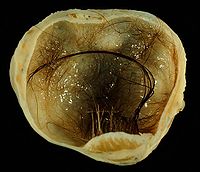
Photo from wikipedia
Testicular teratomas represent a specific entity within the group of germ-cell tumours. They may comprise elements of all three germ layers. In contrast to prepubertal benign teratomas observed in infants… Click to show full abstract
Testicular teratomas represent a specific entity within the group of germ-cell tumours. They may comprise elements of all three germ layers. In contrast to prepubertal benign teratomas observed in infants and adolescents, postpubertal teratomas originate from the malignant germ-cell precursor. Given the good prognosis and curability of most patients with germ-cell tumour, medical oncologists and urological surgeons must be well acquainted with the principles of teratomas management. Surgery plays the decisive part in teratomas treatment, as these tumours are resistant to radio- and, to some extent, chemotherapy. In this article we concentrate on the management of post-chemotherapy resection of teratomatous masses, with special attention to the phenomenon of ‘growing teratoma syndrome’ and somatic-type transformation of teratomas. To understand the nature of teratomas better, we begin with a glimpse of their biological, molecular and immunohistochemical features. Managing germ-cell tumours, teratomas in particular, in high-volume reference centres is of utmost importance to maintain and increase the survivorship rate in these patients.
Journal Title: Medical Oncology
Year Published: 2018
Link to full text (if available)
Share on Social Media: Sign Up to like & get
recommendations!